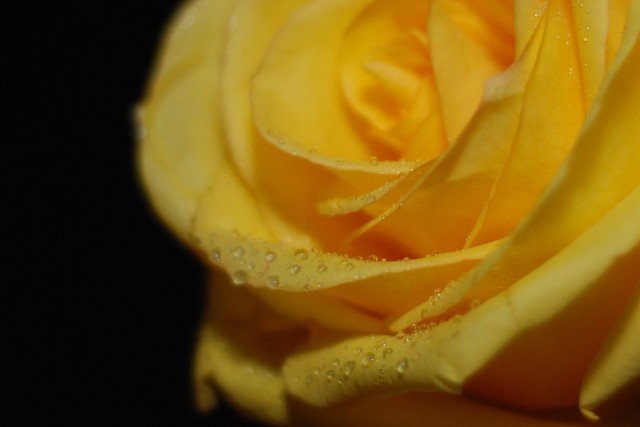I was recently asked a great question about how to diffuse an on-camera flash. This is an important concept to understand—not just how, but why! Today’s photo tip will explain diffusion and how to create and use it.

“Pitiful” captured by latteda
Here is the question I was asked:
“When using flash inside a room with a low ceiling and white walls I understand how to use the flash to get soft light. But if the ceiling and walls are not white, how do you soften the light without off-camera flash?”
This is a great question because it brings out several issues:
- By off-camera flash, he is referring to studio lighting or being able to take the actual flash off the camera. But what if you don’t have any studio lights and your flash either won’t come off the camera, or it will, but you don’t have the necessary gear to use it?
- Why would you want to soften the light in the first place, and what do we even mean by softening the light?
- How does the color of the walls and ceiling affect the light?
- How can we soften it?
If you’re shooting with an undiffused flash—any kind of flash, not just on the camera—it has a tendency to be very harsh. It makes deep shadows on the face and so on.
But, that’s not all, it makes shadows on the walls and ceilings and the color of the light tends to be cold, harsh, and unforgiving.
There are times when this is perfect and just what you’re after, but not usually. Particularly when you’re shooting with a flash unit on your camera.
To soften the light and make it less harsh, we want to diffuse it in some way.
To best illustrate light diffusion, go outside on a bright sunny day and observe your shadow. You’ll notice that it’s dark in color and has a sharp edge. This is caused by the intensity of the light source (the sun) and its size relative to the subject. If you think about it, it’s pretty tiny way up there in the sky!
Now go out on an overcast day, or just wait until a cloud comes between you and the sun. Now the sunlight is entering the top of the cloud and bouncing all over the place. When it comes out the bottom—and hits us—the light is not all coming out in one place. It’s coming out fairly evenly across the whole bottom surface of the cloud. Now our light source becomes the cloud, not the sun. And it’s huge! It’s a lot bigger than the sun was. Possibly from horizon to horizon!
Now look at our shadow. It is no longer such a deep color. It is now more of a gray than black, and it isn’t so harsh. Rather than hard edges, the edges of the shadow are now softer and less defined. They tend to fade away rather than just go from deep black to nothing.
This is diffusion. It softens the light and makes it larger in relation to the subject. That’s why you see studio photographers using softboxes and shooting through umbrellas. It’s an in studio attempt at replicating a cloud.
Back to our on-camera flash…

“Larry Pollman” captured by Michael Carian
Since most of our problems are being caused by the size of the flash relative to the subject, we need to make it bigger. Thus, higher end flash units have the ability to swivel the flash head while it remains on the camera.
Now, rather than shooting straight at the subject with this tiny, harsh light source, we swivel the head and bounce the light off the wall or ceiling. This makes the light a LOT bigger and solves most of our problems.
But, what if the walls and ceiling are not white?
Don’t bounce off of them. The light will pick up the color and reflect it onto the subject’s face. Either move your model to another location or diffuse the light in another manner.
They do sell tiny softboxes that you attach to your on camera flash or white plastic covers you put over the flash lens, but the easiest and most popular way is to tape some sort of diffusion material over the flash. Tracing paper works well and you can increase or decrease the amount of diffusion by the number of layers of tracing paper you use.

“A single rose can be my garden…” captured by Denise Cross
These solutions aren’t ideal; the best way to diffuse a flash is to swivel it and bounce the light into the subject from a wall. But they’ll work in a pinch.
Another bounce option would be to use a large white reflector. Bounce the light off of that rather than the wall.
Using and diffusing on camera flash isn’t difficult, but it is one of those photo tips that just have to be done!
About the Author:
Dan Eitreim writes for OnTargetPhotoTraining. He has been a professional photographer in Southern California for over 20 years. His philosophy is that learning photography is easy if you know a few tried and true strategies.
Like This Article?
Don't Miss The Next One!
Join over 100,000 photographers of all experience levels who receive our free photography tips and articles to stay current:






This blog is very informative. all the tips are really helpful. keep it up
Indeed useful when not bouncing to a wall or ceiling. I use an old fashioned film canister that is white translucent. Some Camera stores still have them. Cut a slit into the canister so it can slide over your popup flash on your camera. That canister will send the light up and forward at a defused source preventing even red eyes.
Important information for sure. But one other method always at hand should still be mentioned. If no white ceilings, no diffusers and no white papers are at hand, there’s always the other hand at hand …..
holding the camera with one hand can be done, especially with on camera flash (short duration of the flash, not a great distance from the subject, most likely a standard lens or short telezoom) …… so the other hand can be used as a reflectorscreen just over the on-camera flash-unit ….. it’s not white …… but it’s not an akward color either ….. so it could really make a difference and avoid the harsh light of the direct flash.
Good ideas, but even with on-flash diffusers light is a bit harsh . . . . if you’re lucky enough to have a person to hold a reflector, should flash still be used with diffuser?
Some useful tips, thanks for sharing them
You mention in your article that I can use tracing paper. My question is can I use wax paper instead??